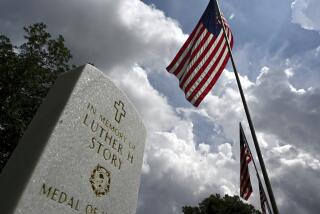Widow Ends Effort to Clear Guardsmanâs Name, but Maintains Her Belief in Him
JAMESTOWN, N.Y. â A bulging three-ring binder tells the story of Gordon Hess. Stacks of commendations from the Army, reminiscences of friends and testimonials from co-workers extol a tender father, courageous firefighter and National Guard captain who seemed destined to lead.
But the story has the saddest of endings.
The last page in the binder is a casualty report from the Army issued after Hess, 38, was found dead on the base at Ft. Knox, Ky. He had been stabbed 26 times, and the casualty report concluded the gashes were self-inflicted.
His wife, Dorene, says itâs obvious: Her husband was murdered.
The Armyâs suicide declaration of March 10, 1998, was issued the very day Dorene Hess was to bury her husband. It became the first volley in a 15-month war between the guardsmanâs widow and the service.
The final blow came in May with the Armyâs confirmation of its initial conclusion: Gordon Hess killed himself.
Dorene Hess will never believe it. But she is done fighting.
âItâs time to go back to what Gordie and I lived for,â she says. âOur children.â
A Living Testimony for the Children
She has been there for them, she says, but not 100%. Not while consumed with protecting her husbandâs honor.
âIt hasnât been a fun ride for me, spending 15 months talking about my husbandâs violated body,â she says.
During that time, the young widow swelled the black binder with independently solicited forensics reports contradicting the Armyâs findings, private investigatorsâ reports and testimonials from acquaintances who said Hess had everything to live for.
Picking up where the family photo albums leave off, the notebook is what Dorene Hess will give her three children so they will know their father as the man his friends, family members, co-workers and military friends saw.
âItâs a living testimony for Gordie Hess. A living one. Not a dead one,â she says.
âHe Was Not a Quitterâ
It is a different Gordon Hess than the one described by Army officials: a guard captain who was so unnerved by a bungled simulation exercise that he plunged a knife into his neck and chest, over and over and over.
Two of the 20 chest wounds perforated his heart, four pierced the left lung and one sliced into his liver.
But even if there had been just one wound, Dorene Hess would not have believed her husband died at his own hand. He would never leave her, their children and their large, close-knit family over what amounted to a video game.
âHe was not a quitter,â she says. She and Hessâ friends recall his favorite saying: âYou learn from your mistakes.â
Dorene Hessâ fight for her husbandâs honor took her from this out-of-the-way town of 35,000 in western New York to the Pentagon and the Washington office of a congressman, where, armed with the black book at a closed-door meeting, she made her case before 15 U.S. Army officials.
Paul Boyce, a spokesman for the Army Criminal Investigation Command, said the Army conducted an exhaustive investigation, analyzing evidence and conducting interviews.
âWe have an obligation to the family, to the community and to the Army family to complete a thorough investigation,â he said. âWe remain committed to properly determining the reason for the loss of life to help the Army avoid future deaths whenever possible.â
Army investigators concluded that Hess was despondent over a computer-simulation exercise in which his unit committed fratricide by firing at friendly tanks. Afterward, he killed himself with a knife purchased on the base a day earlier.
Investigators based their findings on interviews with other guardsmen. They also cited a lack of evidence of a struggle at the scene, and lack of a motive for murder or evidence of an assailant. His wallet, with $81 and credit cards, was still in his pocket. The knife believed to be the weapon was found at the scene but had no readable fingerprints.
A History of Public Service
Dorene Hess relies on âthe court of public opinionâ to balance the militaryâs position. âWe win. They lose,â she says, clutching her husbandâs military cap in her lap. âEveryone knows now that Gordie was murdered.â
âHe doesnât deserve this mark on his death certificate. His three kids donât deserve it, and I donât deserve it,â she says. âHe was a dedicated public servant in the military and the fire department.â
Hess was a Jamestown firefighter with a degree in physical education. He finished first in his class at Officers Candidate School after four years as an enlisted man.
Dorene Hess received a call from her husbandâs best friend, Lt. Jon Burris, a New York State trooper who was also training at Ft. Knox. It was March 3, 1998, and Burris asked if sheâd heard from Gordie. Hess had awakened early, apparently headed out for a run, but he didnât show up for breakfast. His shaving kit and uniform had been laid out.
Absent for an 8 a.m. session at the Simulation Center, he was officially listed as missing at 4 p.m. Search teams scoured the base until 10 p.m. and again the next morning. Burris kept Dorene Hess up to date through frequent phone calls.
Army Uses a Psychological Autopsy
When his calls stopped, Dorene Hess thought the worst. An Army notification team and two pastors at her doorstep confirmed her fears. Her husband, she was told, had been assaulted and killed. A search team had found his bloodied body, face down in an inch of water at the bottom of a ravine not far from the barracks.
Dorene Hess broke the news to her children, Shawna, 13; Sarah, 9; and Samuel, 5.
âI told them that a bad man did something to their father and he wasnât going to come home,â she recalls. It was the hardest thing sheâd ever done.
But worse was to come.
Dorene Hess was preparing for the wake when the fire departmentâs attorney, Charles DeAngelo, told her that he had learned the Army was going to announce that Hess had killed himself.
On the day of the funeral, Dorene Hess made the decision to order a second autopsy. The burial would wait.
Hessâ mother, Elsie, recalls that day.
âEven as we attempted to bury his mutilated body, the Army stabbed him again with a suicide ruling,â she says.
Army investigators often use âpsychological autopsiesâ to assist in rulings of suicide. In Hessâ case, investigators said he had moped around the barracks and couldnât sleep after the failed simulation exercise.
Dorene Hess said her 21 years with him provide the more accurate picture. He had been making long- and short-term plans--to get together with friends, buy his girls a Spice Girls CD, and install a pellet stove. In his last call home, he promised his young son that heâd be back in a few days.
Hess had purchased a knife the day before his death--along with a 437-page book on tank battles, a pair of socks and a captainâs rank patch, all useless to a person about to die.
Even if he were inclined to suicide, Dorene Hess says, as a licensed emergency medical technician he would have slashed his carotid artery or even his wrists, but he wouldnât have stabbed himself 26 times.
Families Unite to Find Answers
Dorene Hess notes the suicide ruling would not be the first to be proven wrong. Navy investigators claimed in 1989 that a gunnerâs mate killed himself and 46 crewmen because he was suicidal. The Navy apologized when it later turned out the explosion was accidental.
Dorene Hess points to dozens of other military families with similar experiences who have united to form a group called âUntil We Have Answers.â
âThereâs no conspiracy. Iâm not a conspiracy person,â says Lois Vanderbur, a member of the group. In 1992 her 24-year-old son Kirkâs death was ruled a suicide after he was shot once in the head and once in the stomach with different weapons found 10 feet apart.
Dorene Vanderbur and the others say they simply want the military to acknowledge mistakes and correct them for familiesâ peace of mind.
âI canât bring my own son back,â Dorene Vanderbur says, but she hopes to ease the pain for others.
Dorene Hess, too, thinks about the military families who will face her heartache in the future. She has drafted a bill of rights for families mandating that no military findings would be released until all investigations were closed and complete with all test results, photos and reports.
Someday she hopes to see the procedures become routine.
More to Read
Sign up for Essential California
The most important California stories and recommendations in your inbox every morning.
You may occasionally receive promotional content from the Los Angeles Times.










